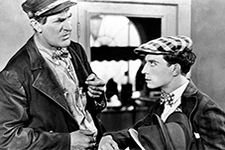Steamboat Bill, Jr.
|  In Steamboat Bill Jr., one of the last of Buster Keaton’s silent features, the infamously stone-faced comedian plays the title character, a dandy college graduate who shows up in a small Mississippi town to meet his father for the first time. His father, the enormous, gruff steamboat captain William “Steamboat Bill” Canfield (Ernest Torrence), is not surprisingly less than enthused when he discovers that his son, far from being a strapping chip off the ol’ block, is a diminutive intellectual with a taste for flashy European clothing and ridiculous pencil moustaches. Thus, Keaton is playing another of his out-of-place underdogs who must prove his worth by the end of the film by living up to the expectations of his towering father while also sticking it to J.J. King (Tom McGuire), the wealthy tycoon who intends for his new, fancy steamboat to take the place of Steamboat Bill’s creaky old vessel, the “Stonewall Jackson,” which has plied the river for decades. Things get complicated when Keaton’s character becomes involved with Kitty (Marion Byron), the King’s winsome daughter, and they find themselves in an amusing Romeo-and-Juliet situation in which neither father wants his offspring being involved with his rival’s. Of course, like most of Keaton’s films, the story is just a set-up for the comedy, which Keaton executes with his trademark combination of perfectly timed derring-do and taciturn nonchalance. Carl Harbaugh, who had co-written Keaton’s previous film College (1927), is credited as the sole screenwriter for Steamboat Bill Jr., although the film’s director, Charles Reisner, brought the idea to Keaton, who devised most of the story and all the gags himself, such as the hilarious sequence in which Keaton’s character tries to get his father, who is in prison and is refusing to speak to him, to accept a load of bread in which he is clearly hiding tools to aid in his escape. Keaton keeps pantomiming behind the sheriff’s back what is inside the bread to his stubborn father, who is so angry with him that he keeps missing the obvious. The film’s stand-out sequence, though—and it is one of the most famous sequences in all of Keaton’s films—is the cyclone sequence, which is one of Keaton’s greatest “trajectory gags” (interestingly, the sequence was originally intended to be a flood, but was changed at the last minute when the producer decided that a flood would be too distressing for the audience). While his father is stuck in prison and Keaton is in the hospital with a bump on his noggin, a massive wind storm descends on the town, tearing down buildings and blowing trees through the air (all of the technical effects were the work of technical director Fred “Gabe” Gabourie, one of the unsung heroes of Keaton’s oeuvre who had worked with him building sets and props and devising contraptions to bring Keaton’s ideas to life since the 1920 short One Week). For an impressively sustained period of time, Keaton navigates the ravages of the cyclone, avoiding collapsing building fronts, making his way through the remnants of a theatre and its various props (an obvious nod to his vaudeville days), and trying to stand upright in gale-force winds. The moment that everyone remembers is the one in which Keaton is standing in the street in front of a two-story building, the entire front of which peels off and collapses on top of him. Keaton his spared only because he is standing in the exact spot where the open attic window lands. It’s a hair-raising moment of grand physical comedy because we sense the real danger of the stunt; it is clear that the collapsing building is heavy (two tons, in fact) and Keaton’s life and limb are assured by mere inches. Steamboat Bill Jr. was the only major collaboration between Keaton and prolific director Charles Reisner, who, like Keaton, had started in vaudeville before getting into movies first as an actor (he played a memorable role in Chaplin’s first feature, The Kid [1921]) and then as a director. Prior to College, Keaton had directed or co-directed all of his features, so his lack of credit here is an unfortunate indicator of his waning power and stature in the industry (this was the last of his independent films, as Buster Keaton Productions, which was created under the auspices of producer Joseph M. Schenck, was dissolved and Keaton went under contract with MGM). Keaton has said in various interviews that he was angry and despondent about the trajectory of his career while he was making the film, which partially explains his willingness to do the collapsing building stunt. It didn’t help that the film was a box-office failure, which increased the perception that Keaton’s career was at an end as silent cinema gave way to talkies. Rarely has a film so good been the beginning of the end of a genius’ career.
Copyright © 2019 James Kendrick Thoughts? E-mail James Kendrick All images copyright © Cohen Film Collection | |||||||||||||||||||||||||||||||
Overall Rating: 


 (3.5)
(3.5)


